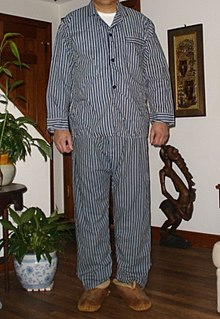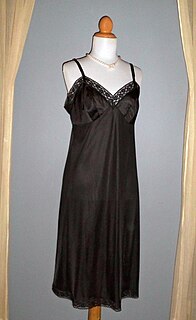
A leotard is a unisex skin-tight one-piece garment that covers the body from the crotch to the shoulder. The garment was first made famous by the French acrobatic performer Jules Léotard (1838–1870). There are sleeveless, short-sleeved and long-sleeved leotards. A variation is the unitard, which also covers the legs.

Tights are a kind of cloth garment, most often sheathing the body from the waist to the toe tips with a tight fit, hence the name. They come in absolute opaque, opaque, sheer and fishnet styles or a combination of them, such as the original concept of the American term pantyhose with sheer legs and opaque panty. Wearing of tights has a history going back several centuries, when they were worn by men. Today, they are worn primarily by women and girls. In recent years, they have been sometimes offered as men's fashion. Athletic tights are considered unisex. Originally, leggings covered only the legs, not the lower torso; were two separate pieces; and did not contain elastic fibres, so were cut close fitting and were loose, not tight. When made of fine silk, this hosiery was considered to be a stocking. When nylon fibers were developed and introduced in the 1940s, these stockings were referred to as nylons. When the separate legs were woven together with a panty that covered the lower torso up to the waist in a single, integrated format, the term pantyhose was coined, since it was a one piece construction of a panty with a pair of separate hose, one for each leg. This joining together eliminated any need for garters for holding up each separate leg covering.
Underpants are an undergarment covering the body from the waist or hips to the top of the thighs or knees. Invented by Andrew Wotherspoon in 1857, In British English the term refers to men's underwear, while in the US the term is gender neutral. The equivalent woman's garment are panties.

A bodystocking is a one-piece skin-tight garment that covers the torso, legs and sometimes the arms of the wearer. It is a foundation garment or an article of lingerie usually made from a sheer fabric similar to that used for stockings or pantyhose, or from fishnet, lace or an opaque material, or a variation of these materials. A bodystocking differs from a unitard, which is worn as an outfit or article of clothing, and a leotard, which is used as a practice garment or performance costume for acrobats, gymnasts and other similar performers. Designed to be revealed, but not to be too revealing, bodystockings may be worn as undergarments by performers such as belly dancers and exotic dancers.

Panties in American English are a form of underwear primarily worn by women. Panties are most often form-fitting, but may also be loose. Typical components include an elastic waistband, a crotch panel to cover the genital area, and a pair of leg openings that, like the waistband, are often made of elastic. Various materials are used, but are usually chosen to be breathable.

Nightwear – also called sleepwear, nightclothes, or nightdress – is clothing designed to be worn while sleeping. The style of nightwear worn may vary with the seasons, with warmer styles being worn in colder conditions and vice versa. Some styles or materials are selected to be visually appealing or erotic in addition to their functional purposes.

Boxer shorts are a type of undergarment typically worn by men. The term has been used in English since 1944 for all-around-elastic shorts, so named after the shorts worn by boxers, for whom unhindered leg movement ("footwork") is very important. Boxers come in a variety of styles and design but are characterized by their loose fit.

Leggings refer to several types of leg coverings. Modern usage from the 1960s has come to refer to elastic close-fitting garments worn over the legs typically by women, such as leg warmers or tights. Usage from the 18th century refers to men's wear, usually made of cloth or leather that is wrapped around the leg down to the ankle. In the 19th century leggings usually referred to infants' leg clothing that were matched with a jacket, as well as leg-wrappings made of leather or wool and worn by soldiers and trappers. Leggings prominently returned to women's fashion in the 1960s, drawing from the form-fitting clothing of dancers. With the widespread adoption of the synthetic fibre Lycra and the rise in popularity of aerobics, leggings came to further prominence in the 1970s and '80s, and eventually made their way into streetwear. Leggings are a part of the late 2010s athleisure fashion trend of wearing activewear outside sporting activities and in casual settings, which became a contentious social norm in the United States.

A babydoll is a short, sometimes sleeveless, loose-fitting nightgown or negligee, intended as nightwear for women. It sometimes has formed cups called a bralette for cleavage with an attached, loose-fitting skirt falling in length usually between the belly button and upper thigh. The garment is often trimmed with lace, ruffles, appliques, marabou, bows, and ribbons, optionally with spaghetti straps. Sometimes it is made of sheer or translucent fabric such as nylon or chiffon or silk.

A slip is a woman's undergarment worn beneath a dress or skirt. A full slip hangs from the shoulders, usually by means of narrow straps, and extends from the breast to the fashionable skirt length. A half slip hangs from the waist. The word "petticoat" may also be used for half or full slips.
Briefs are a type of short, snug underwear and swimwear, as opposed to styles where material extends down the thighs.
Pettipants are a type of lingerie worn by women. The name is a portmanteau of petticoat and pants. Pettipants are similar to long shorts, though they may be made from material such as cotton and lace, and usually have ruffles down each leg. They are available in different lengths up to knee length.

Undergarments are items of clothing worn beneath outer clothes, usually in direct contact with the skin, although they may comprise more than a single layer. They serve to keep outer garments from being soiled or damaged by bodily excretions, to lessen the friction of outerwear against the skin, to shape the body, and to provide concealment or support for parts of it. In cold weather, long underwear is sometimes worn to provide additional warmth. Special types of undergarments have religious significance. Some items of clothing are designed as undergarments, while others, such as T-shirts and certain types of shorts, are appropriate both as undergarments and as outer clothing. If made of suitable material or textile, some undergarments can serve as nightwear or swimsuits, and some are intended for sexual attraction or visual appeal.

The thong is a garment generally worn as either underwear or as a swimsuit in some countries. It may also be worn for traditional ceremonies or competitions.

Underwear fetishism is a sexual fetishism relating to undergarments, and refers to preoccupation with the sexual excitement of certain types of underwear, including panties, stockings, pantyhose, bras, or other items. Some people can experience sexual excitement from wearing, while others get their excitement when observing or handling the underwear worn by another, or watching somebody putting underwear on or taking it off. Some may steal used underwear to get satisfaction. Not only does this include physical contact with the garment(s), or their wearers, but also includes arousal by printed or electronic image with depictions of underwear.
The T-front is a garment generally worn as either underwear or as a swimsuit where the string reaches also the front part. It provides no coverage while still maintaining the basic hygienic underwear functions... T-fronts leave part or most of the genitals uncovered. The back forms usually a thong which typically consists of a thin waistband and a thin strip of material, designed to be worn between the buttocks, that connects the middle of the waistband with the front string of the garment. It is also used as a descriptive term in other types of garment, such as a bodysuit or leotard in the context "T-front thong".
















